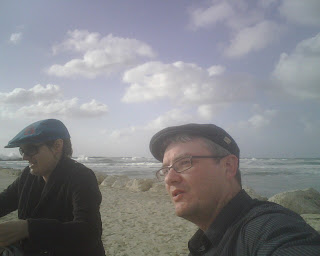Thoughts Leading To Thoughts on Tikkun Olam
 (Picture note: 17th century Italian Ark from the Istanbuli Syanagogue in Old City, Jerusalem.)
(Picture note: 17th century Italian Ark from the Istanbuli Syanagogue in Old City, Jerusalem.)
I suppose that for a future rabbi the fact that Synagogues are such a comforting place is a good thing. After all, if everything works out I’ll be spending a bit of time in them for the remainder of my life. So this wonderful opportunity to continue exploring all shapes and sizes and traditions of Synagogues is as much an exploration of what exactly about synagogues gives this comfort as it is expanding that comfort zone. As the prayerbook daily becomes more familiar, thanks to that melding of activities called “liturgy class” and “improving my Hebrew,” some of the last things that were not comfortable have given away and allowed me to finally face things that are truly uncomfortable.
Before anyone comments that this makes no sense, let me try and clarify. When I attended Hebrew University last summer and spent the majority of my prayer time between the two orthodox synagogues (one Sephardic, one Ashkenazi) on top of French Hill, my comfort factor rested evenly between “very” and “not at all”—“very” in that 4 hours of prayer is one of the most amazing places that I can exist, in that time often entering into a meditative state where the sounds of prayer and Torah wash over and through me until I find myself on the other side refreshed, renewed, and radically amazed. The “not at all part” came almost exclusively from the reality that I could not keep pace in an orthodox prayer book with a teleprompter and a bouncing ball. As a result of the average—the state of “not really” being comfortable, I generally hid in far corners and snuck away as quickly as possible to avoid having to face my perceived inadequacies through another’s eyes. Then I went back to
. . . All of which leads me back to my original thoughts. Now as I explore new synagogues, I have stopped hiding in corners, stopped feeling inadequate, and starting having the amazing conversations that one has when one acts as a member of a community rather than just sitting on hard chairs merely as the theoretical member of one.
It was within this context that I visited the Spanish and Portuguese Minyan in the
Davening in such environs was for me no less inspiring than the building. The congregation here ensured that the mehitzah stood much less intrusive than the average Yerushalmi religious barrier, and so with my usual concern and accompanying pangs of guilt about praying in a place that is antithetical to my stance on gender equality set aside, I prayed.
The crux of the story, however, is not the prayer. Certainly the time of prayer, although not solely Spanish/Portuguese nusach, lived up to its billing as a unique and enjoyable prayer experience. The congregation honored another Abraham Geiger student with the carrying the Torah and honored me with an aliya-ha-torah. Three different schliachey-tzibur offered different strengths of beauty and kavanah within the near perfect acoustics. All and all, simply said, it was a positive experience.
Except . . .
I have begun developing my presentation style and content when it comes to defending my decision to serve in
Yet for all the sincerity and impact of the words, the reality is that for many the Holocaust is much more than a movie or a few pages in a history book. For many the Shoah still unsheathes righteous and visceral anger, and one such as I that would choose—choose—to go to
I have other words that I speak just as sincerely—that Germany is unique in all of history in its acts of tikkun olam—that unlike most other nations, and there have been many, that have perpetuated horrors on its own or other populations, Germany has admitted to responsibility, worked at reparations, created a national consciousness around the issue, and whose citizens as a whole acknowledge to very deep levels a collective guilt and shame. Certainly as I speak these words I have no expectations that one within righteous anger could and should accept these words as a prompt for transformation. They are simply words that can do little against the very real hurt and loss of those whose family trees mingled with the other ashes of the Nazi horror.
Yet I am nonetheless on this path and remain firmly on this path, and when an elderly gentleman visiting this congregation asked me about my life path, his reaction served as a potent reminder for the stakes that any Jew has in this path. I will not repeat the words said, but they were neither gentle nor forgiving. They were, however, real and valid and a part of the greater reality that always needs to be faced while participating in tikkun olam—the reality that to heal something that is broken, it first must be broken in order to be healed.

Comments